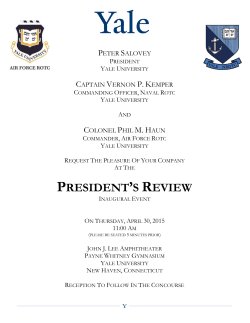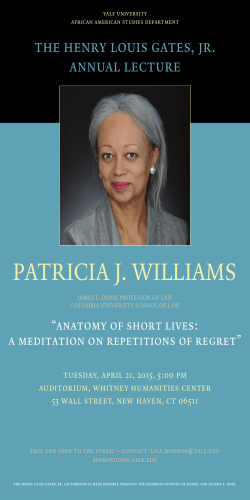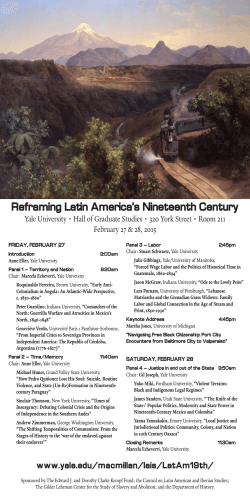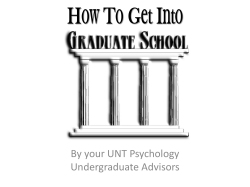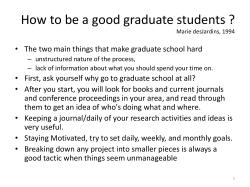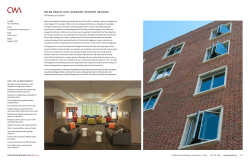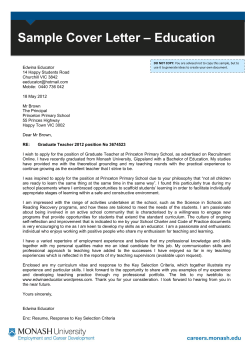
S t P
Sample Teaching Statement (Music) McDougal Graduate Teaching Center (2006) S tatement of Teaching P hilosophy As a teacher, I aim to perpetuate knowledge and inspire learning. More specifically, as a musicologist I introduce students to a canon of musical works and ask them to articulate their reactions, not only presenting a repertoire but also teaching independent critical listening and thinking. To this end, I seek a balance in my courses between lecturing to students and asking them to make discoveries. I encourage students to engage with the topic at hand, with me, and with each other in the belief that good teaching depends upon intellectual exchange. My approach to student assessment reflects my two goals. First, the student is expected to master a body of knowledge by demonstrating on exams a familiarity with those composers, pieces, terms, and concepts studied in the course. Second, students are given the opportunity to reflect upon the material at greater leisure in written assignments that emphasize the skills of critical think ng and listening acquired during the semester. While my standards are high, I help the students to meet expectations by providing office hours, review sessions, and the chance to submit draft papers and revisions. I believe in a flexible manner of instruction, responsive to the unique atmosphere of a given class. In conducting either a large lecture or small seminar, I am aware of students’ different experiences and temperaments in hopes of developing their strengths while ameliorating their weaknesses. Every student, regardless of background, can improve his or her ability to listen to and understand a piece of music. In lectures, discussions, and assignments, I show that music responds to various modes of inquiry: analytic , hermeneutic, cultural, and historical; thus, students are equipped to explore the possibilities of each perspective and emboldened to push beyond their own experience to expand their skills. In the end, I have enriched a student’s ability to think about, discuss, and listen to music with a new awareness of its aesthetic and humanistic significance. Sample Teaching Statement (History) McDougal Graduate Teaching Center (2006) STATEMENT OF TEACHING PHILOSOPHY When I first began studying history in college, I knew very little of European history or how to write a historical essay. I approached history from a perspective of genealogy and American family history. Thanks to great teachers, I learned how to construct an effective historical argument and grasped the significance of history for contemporary Europe. In my teaching I aim to evoke the same excitement of discovery and achievement that I felt, ten years ago, as a nonspecialist entering the field. In the classroom, I engage students with vibrant historical themes, using music, art, pnmary accounts, literature, economic theory, and strategic analysis. I am sensitive to the students’ backgrounds and goals in my lectures and seminars, aiming to connect with their personal experience. Among the academic disciplines, history offers a unique perspective on ourselves and the world. History also offers excellent opportunities for developing research, writing, and analytical skills, which are central to any professional career. Studying history can make students more active and responsible citizens, and be the highlight of an undergraduate’s career. I have grown to love teaching all levels of undergraduates. Students are at the center of my lesson planning process. My first goal is to create an atmo- sphere that encourages participation and involvement. I present historical themes and material which are gauged to students’ needs and interests. I organize assignments to promote critical analysis of primary and secondary sources. Where possible, I assign several writing assignments through the semester, so students can improve over time. Students are encouraged to come to my office hours, especially to discuss ideas, plans, and style before and after writing. Finally, I present exams not merely as evaluations, but as an opportunity for students to understand and synthesize the semester’s work. My review outlines for the exams help students see the big picture and link together the course’s themes. My students at Yale have struggled with a variety of academic problems. To encourage par- ticipation in class discussion, I have individually encouraged timid students to prepare questions or one or two comments before coming to class. This has worked well. Sometimes I assign weekly Sample Teaching Statement – History – p. 2 reading responses, or short in-class present ations by one or two students a week, on related topics not studied by the entire class. This gives the presenter a sense of responsibility and ownership for the topic, and enlarges the course’s scope for all the students. Some students are unable to complete the assigned reading on time,so I often bring up selected passages in class for discussion. This allows comments by everyone, without stifling those students who have read the complete assignment. To bring clarity and vitality to historical events, I have used a variety of media. I have played 1950s recording s of Wagnerian opera and 1920s recordings of Italian immigrant ballads from New York City’s Little Italy; shown slides of French and Italian modernist art and architecture; and played tapes of Winston Churchill’s radio addresses from World War II. I also choose the writings of young men and women, and university students, as primary sources and assignments. In my courses, textbooks play a secondary role to the vivid primary material. Works my classeshave studied include the Communist Manifesto, George Orwell’s Homageto Catalonia, and the shipboard diaries of English emigrants. Teaching is central to my past and future as a historian. Face-to-face instruction has continu- ally challenged me to make lessons fresh and effective. Teaching history to students is exciting in its demands and personally rewarding. It has also improved my research and writing, as I review and present topics in different ways, with broad perspectives, and to new audiences. Sample Teaching Statement (Political Science) McDougal Graduate Teaching Center (2006) Statement of Teaching Philosophy There is, has been, and will always be a certain group of people whom inspiration visits. It’s made up of all those who’ve consciously chosen their calling and do their job with love and imagination….Their work becomes one continuous adventure as long as they manage to keep discovering new challenges in it. – Wislawa Szymborska, 1996 Nobel Prize for Literature Lecture Why do I teach? Here I borrow from a poet. Teaching is my chosen calling, a calling I strive to undertake with love and imagination, and from my location as a relatively new teacher, I see no end to improvement, no arrival, no completion: I want to be that teacher who, even after decades in the classroom, still leaves each session asking how the next might be better, how to better engage and inspire this unique set of students. I bring three overarching objectives to the classroom, each of them rooted in my conception of teaching as an invitation to relationship. First, I invite students into relationship with the specific course material. As a teacher of politics in the context of a liberal education, I see my task as creating spaces for students to encounter—at both a normative and empirical level—fundamental questions of power, justice, identity, equality, and freedom, and to do so in a manner that connects with rather than builds walls between other subfields, disciplines, and modes of inquiry. I design my courses to stretch students in many ways—imaginative and theoretical, empirical and normative, comparative and specific—and an important measure of a student’s success is his or her capacity, at the semester’s end, to critically engage the course topic from a variety of perspectives and traditions. In addition to assessing a student’s factual grasp of material (for example, a map quiz identifying countries and capitals in a course on Southeast Asian Politics), I use exams, essay topics, and research projects that are open ended with no single “correct” answer. I am more interested in developing a student’s capacity to argue cogently, persuasively, and synthetically than in the particular content of his or her conclusions. Inviting my students into relationship with the course material also means encouraging active and participatory learning, and whenever appropriate I bring students into direct engagement with primary sources before turning to the various mediations of secondary literature. Simulations, debates, role playing, thought experiments, and games are a regular part of my classes. In my Moral Foundations of Politics section, students take on the roles of hardline and moderate Iraqi Sunnis and Shiites in order to better understand the complex challenges of crafting a system of democratic representation in a divided society. When reading Robert Nozick’s Anarchy, State, and Utopia, the class divides into anarchists and minimalists and debates the justification for the existence of the state. To explore John Rawls’ difference principle, students pair off and negotiate how to divide a pool of grade points starting from radically unequal positions. Recognizing that not all students are temperamentally inclined to speak out in group settings, I also require regular written reactions to the readings, pushing students to go beyond mere summaries of the material, and I provide extensive feedback on this and other written work. Sample Teaching Statement – Political Science – p. 2 Second, I invite students into relationship with me and with each other. Early in the semester, I learn each of my students’ names and something of their backgrounds, and I model and explicitly lay out guidelines that make passionate yet respectful exchanges of ideas possible. To the extent allowed by class size and subject matter, I seek out physical arrangements that place me in a circle with my students rather than as one set apart behind a podium. This attitude of accessible partnership extends beyond the classroom to my office hours, my willingness to read drafts and suggest revisions, my midterm and final review sessions, my availability by e-mail and phone, and the midterm and final evaluations of my teaching which allow me to adapt to the differing needs of each new group of students. I take seriously my responsibility to guide discussion and to explicate new or difficult material, but I do so in a manner that encourages rather than suffocates thoughtful dissent and lively questioning. For example, I often passionately engage a particular point of view and then turn with a sense of humor to critique my own exposition. To nurture a sense of ownership and involvement, I typically assign two students to start each class period with a series of provocative and thoughtful questions about the material. In addition, I require students to post their reading reaction assignments to a class list-serve, and in class I often reference these postings by name and encourage others to do the same. I find great joy in watching a classroom of strangers grow into an intellectual community of interlocutors over the course of the semester. Third, I invite students into relationship with the larger world around them. I am always conscious of the ways in which the walls of the classroom threaten to hem in a stale air of unreality, and whenever possible I spur students to develop, extend, and test their insights in the broader world. When teaching political theory, I seek to relate big questions and themes to pressing issues and current events, whether those be a pending strike by a local union or a genocide taking place in full view of the world. When teaching comparative politics, I encourage students to extend analyses to countries in which they might have a specific interest. The culminating project of my Dirty and Dangerous Work seminar is an oral history in which students observe and interview workers involved in dirty or dangerous work and then relate their findings back to the major themes developed in the course. As I continue to learn and grow as a teacher, I view experiential and service learning as extremely promising areas for further exploration. It is no accident that the word invitation figures prominently in this teaching statement. Ultimately, I believe teaching can be no more or less than an invitation to relationship. If genuinely self-motivated, lifelong learning is to take place, if students are to develop understandings and analyses of power, justice, equality, identity, and freedom that enable them to grow as critically informed and active citizens of their communities and the world, the choice about whether to accept the invitation must always remain theirs. As a teacher, it is my calling, my continuing adventure, to make that invitation to relationship as compelling, engaging, and persuasive as possible. There have been few moments in my professional life capable of approximating the fulfillment of having students respond to that invitation to relationship with a yes. This yes, for me, comes as close to a visit from inspiration as it gets. Sample Teaching Statement (Psychlogy) McDougal Graduate Teaching Center (2006) PHILOSOPHY OF TEACHING As a teacher I strive to engage, challenge, and inspire growth in my students. It is my belief that every student is capable of tasting the passion that I feel for psychology by becoming collaborators in the exploration of psychological theory, research, and practice. To engage my students in the study of psychology, I begin by crafting stories that draw them into the thick of the learning experience. Behind every statistical technique, clinical intervention, and theoretical argument is a vivid anecdote , and I believe that it is my job, in part , to share these tales with my students. I prefer to teach through demonstrations: by conducting mini-experiments and analyzing data in the classroom, by participating in small group debates and role-plays , by observing and chronicling behaviors from “the real world,” and by discussing clinical case studies . I aim to immerse my students in the topics that I love. I believe that psychology, like a foreign language, is best learned by immersion -immersion in the context that led the researcher, teacher, or clinician to ask her question about the human mind. To challenge and be challenged by my students is my second goal. I begin with the belief that every student possesses unique capabilities that can be shared with others if given the appropriate supports. I challenge my students to share opinions with and to mentor one another. I encourage brainstorming sessions, group projects, and group presentations. It is my hope that students leave my classroom knowing what it means to be a collaborator. I also expect to be challenged by my students—an expectation I hope to communicate to the class early on. I encourage my students to ask questions, and I am straightforward about not having all of the answers. When I become “stuck” I seek the input of my colleagues, my books, and the endless array of resources that can be found on the Internet. When I next return to the classroom, I share not only the answer that I’ve found, but also the process I went through to discover it. Above all else, I challenge my students to understand that I am open to their thoughts, eager to hear their opinions, and thrilled to learn with and through them. Finally, I attempt to inspire growth in my students by giving them tools to take into other disciplines and into other domains of their life. Among these tools are a sense of curiosity, open-mindedness, and a thirst for knowledge. I would like my students to observe and begin to question the purpose and meaning of human thought, behavior, and emotions. After becoming skilled observers, I would like my students to use their tools to ask a few good questions, to creatively design a way of answering these questions, and to openly share their new knowledge with others. One of the beauties of psychology is its ability to translate across many disciplines and across many areas of life. Although my passion is for psychology in particular , one of the greatest goals I have is to teach my students to become motivated, insightful, and enthusiastic thinkers. Sample Teaching Statement – Psychology – p. 2 TEACHING EXPERIENCE It is with great excitement that I look ahead to being a professor, given the experiences that I have had with teaching over the past six years. I have been fortunate enough to be a teaching fellow in a number of courses beginning when I was an undergraduate at Stanford, and continuing during my time at Yale. In each of these courses, the professor offered me a great deal of autonomy to give a guest lecture and/or lead sections in addition to holding office hours, constructing exams, and grading papers. I have also had the opportunity to be a co-instructor in three courses: Social Psychology, Multivariate Statistics, and The Intelligent Emotions. Each course presented a wonderful opportunity to learn and to grow as a teacher. (Summaries of student evaluations of my instruction follow.) I co-taught Social Psychology with another graduate student through Yale’s Summer Program. Among our students were Yale undergraduates, undergraduates from other universities, and advanced high school students. We designed the entire course and lectured, led discussions, and conducted demonstrations in every class. I learned a great deal about tailoring the pace and content of the material to the expertise and interests of the students, which was an exciting challenge given the diversity of the class. The Multivariate Statistics class that I co-taught was geared toward graduate students (with one or two talented undergraduates among the ranks). I worked closely with the professor, but gave a series of lectures over the course of the semester using many of my own materials. In this class, I learned how to make statistics fun, by appealing to the utility of the topic (for research and for better arguing a point in the real world) as well as by attempting to use compelling examples in each lecture. Finally, I co-taught The Intelligent Emotions on-line for Yale Alumni. This was an amazing experience in that I had never before had the opportunity to use the World Wide Web as a classroom. The experience presented its own challenges (e.g., Can enthusiasm for a subject be adequately communicated over cyberspace?) and its own strengths (e.g., having students from across the country and the globe, of all ages and backgrounds, participate in the class). Intimately linking technological advances with classroom experiences is certain to become the norm, and I feel fortunate to have already “gotten my feet wet” in this teaching medium. Another domain in which I have gained teaching experience over the past few years is as a clinical psychologist in training. I was given the unique opportunity to be the Assistant Director of the Yale Psychological Services Clinic in my fourth year of graduate school. In that role, I not only assisted in the Assessment and Clinical Practice course for first-year graduate students, I also supervised these students in conducting clinical work and writing intake reports. One student described in the year-end evaluation that I was “a very sensitive supervisor who always made me feel my input was important.” Another described, “I can’t think of anything in Jerusha’s supervisory repertoire that could be improved. I think that she should keep doing what she is doing.” In commenting on my written feedback on write-ups of clinical interviews, he describes, “Incredible! My previous supervisor was a journal Sample Teaching Statement – Psychology – p. 3 editor...getting a report back from Jerusha reminded me of working with him!...Jerusha’s comments greatly improved the quality of my report, both in terms of content and writing style.” As an adjunct to my commitment to clinical training, my colleagues and I are working on writing a training manual for treatment planning, goal-setting, and assessment that will be published by Guilford Press. A shortened version of our manual is now being used as part of Yale University’s clinical training program. Currently, in my clinical internship at McLean Hospital, I am leading 9 different treatment groups (e.g., cognitive behavioral therapy skills, depression and anxiety, body awareness, life transitions, goal setting, bipolar interpersonal issues) for individuals with severe anxiety, depression, and psychoses. Although these treatment groups are clearly therapeutic in nature, many of them are geared towards psychoeducation, which allows me to continue growing as a teacher as well as a clinician. MENTORING GOALS AND EXPERIENCE My desire to engage, challenge, and inspire growth in my students is not limited to the classroom. Over the time that I was at Yale I worked with over a dozen undergraduates as a research mentor and closely advised three students on their senior projects. My desire to collaborate with students translates into the research domain; two of my papers that are “work in progress” are co-authored with undergraduates. It is my goal to share with students the awe and excitement, as well as the dedication and hard work, that comes along with using psychological research tools to ask and answer questions. All three of the undergraduates that I advised went on to graduate school—two are currently in education and one is a social psychologist in training (studying at the University of California at Berkeley). Finally, it is critical to note that classes and workshops that feature pedagogical issues are a priority to me, and I hope to continue taking courses similar to those I have had at Yale (such as Peter Salovey’s Teaching Undergraduate Psychology and Yale’s Working at Teaching Seminar) in the future. I hold myself to the same standards that I hold my students. That is, I strive to become a skilled thinker and learner, and I believe that this process is life-long. For a more detailed description of my teaching experience, innovations, and evaluation, please contact me for a copy of my Teaching Portfolio.
© Copyright 2025
